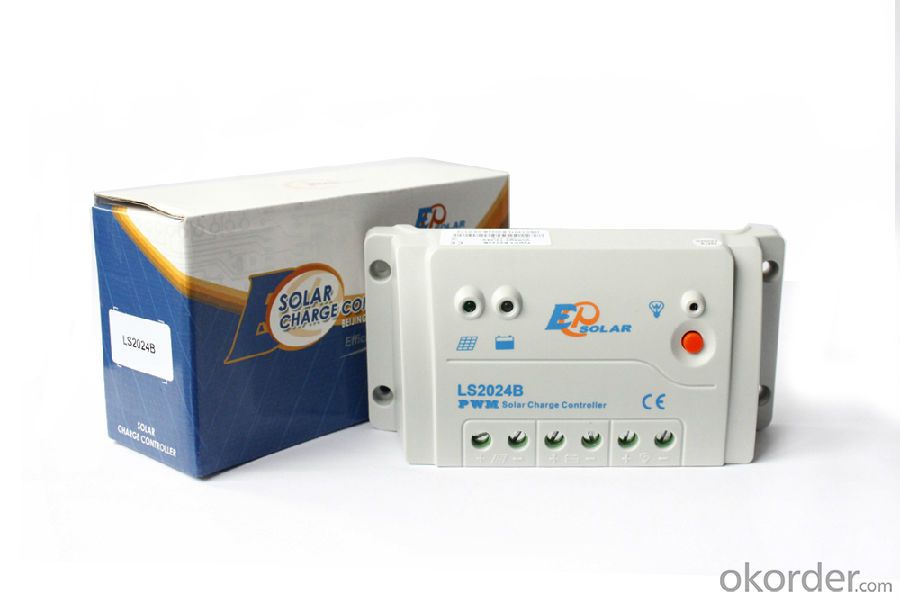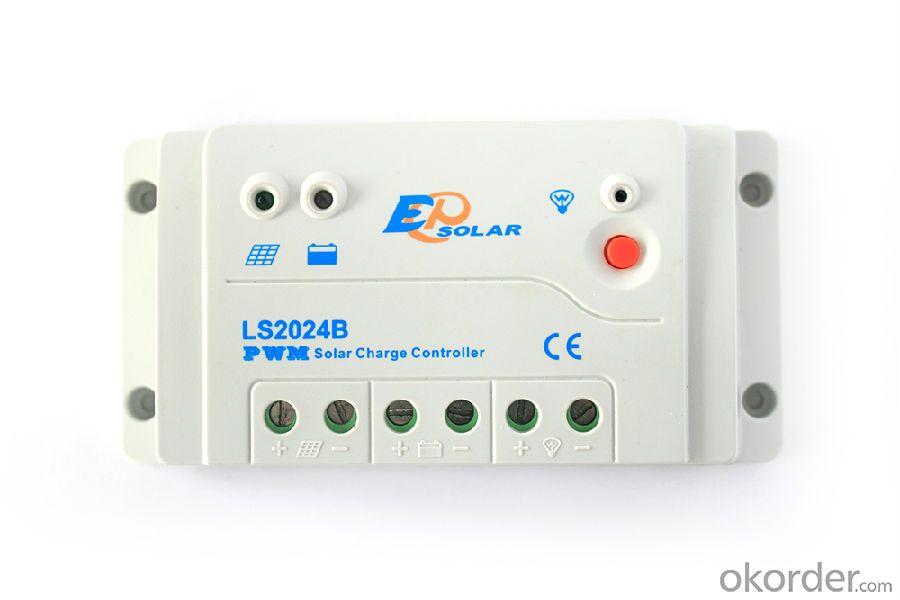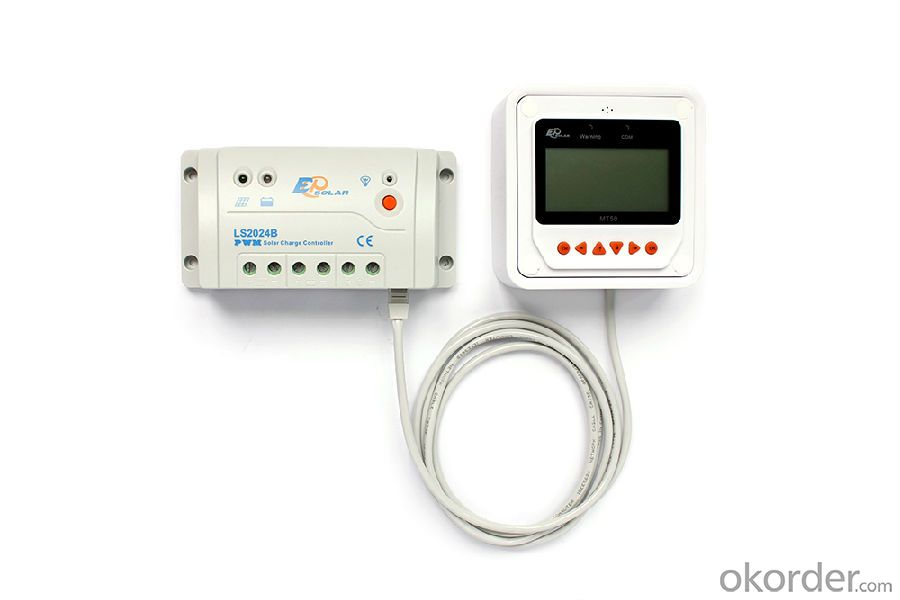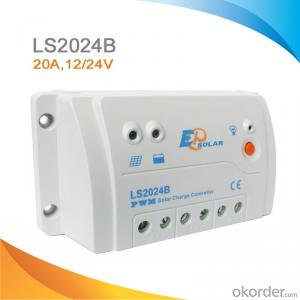PWM Solar Charge Controller,20A 12/24V,LS2024B
OKorder Service Pledge
OKorder Financial Service
You Might Also Like
Descriptions:
A charge controller, or charge regulator is basically a voltage and/or current regulator to keep batteries from overcharging. It regulates the voltage and current coming from the solar panels going to the battery. Most "12 volt" panels put out about 16 to 20 volts, so if there is no regulation the batteries will be damaged from overcharging. Most batteries need around 14 to 14.5 volts to get fully charged.
Features:
·High efficiency PWM charging with temperature compensation
·3 LEDs shows PV charging, battery and load status
·External temperature sensor interface
·RS-485 bus communication
·Open standard Modbus communication protocol
·Software update function
·Diversified load control modes : Manual, Light ON/OFF, Light ON+ Timer, Time Control
·Battery type selection: Gel, sealed, flooded and User type
·Real-time monitor
·Programmable parameters
·LVD or SOC load disconnect function
·Energy statistics function
Electronic Protections:
·PV short circuit
·PV reverse polarity
·Battery overcharge
·Battery over discharge
·Battery reverse polarity
·Load short circuit
·Load overload
·Overheating
Specification:
Electrical parameters | LS1024B | LS2024B | LS3024B |
Nominal System Voltage | 12 / 24V auto work | ||
Rated Battery Current | 10A | 20A | 30A |
Maximum battery voltage | 50V | ||
Grounding | Common positive | ||
Self-consumption | 8.4mA(12V),7.8mA(24V) | ||
Temp. compensation | -3mV/℃/2V(25℃ ref) | ||
Equalize charging voltage | Sealed: 14.6V, Flooded: 14.8V, User-defined: 9~17V | ||
Boost charging voltage | Gel: 14.2V, Sealed: 14.4V, Flooded: 14.6V, User-defined: 9~17V | ||
Float charging voltage | Gel /Sealed /Flooded: 13.8V, User-defined: 9~17V | ||
Low voltage reconnect voltage | Gel /Sealed /Flooded: 12.6V, User-defined: 9~17V | ||
Low voltage disconnect voltage | Gel /Sealed /Flooded: 11.1V, User-defined: 9~17V | ||
Working temp. | -35℃~+55℃ | ||
Humidity | ≤95% (NC) | ||
Enclosure | IP30 | ||
Dimension | 138.6x69.3x37mm | 159.6x81.4x47.8mm | 200.6x101.3x57mm |
Terminal | 4mm2 | 10mm2 | 10mm2 |
Net weight | 0.13kg | 0.3kg | 0.5kg |



- Q:Can a solar controller be used with a solar-powered waste management system?
- Yes, a solar controller can be used with a solar-powered waste management system. A solar controller is responsible for regulating the charge and discharge of batteries connected to the solar panel. In a solar-powered waste management system, the solar controller helps to efficiently charge and manage the batteries that power the system, ensuring optimal performance and longevity.
- Q:How do I protect a solar controller from theft or vandalism?
- There are a few measures you can take to protect a solar controller from theft or vandalism. Firstly, consider installing the controller in a secure and discreet location, such as inside a locked enclosure or in a well-hidden spot. Additionally, you can use tamper-proof screws or locking mechanisms to secure the controller in place, making it difficult for unauthorized individuals to remove or tamper with it. Installing surveillance cameras or motion sensor lights near the controller can also act as a deterrent and help identify any potential culprits. Lastly, consider labeling the controller with warning signs indicating that it is under surveillance or monitored, which can discourage theft or vandalism attempts.
- Q:What is the maximum input power that a solar controller can handle?
- The specific model and technical specifications of a solar controller determine its maximum input power capacity. Solar controllers are generally designed to accommodate various solar panel configurations and sizes by being capable of handling a wide range of input power levels. The maximum input power capacity of a solar controller is typically indicated by its maximum supported solar panel wattage. For instance, a solar controller may have a rating of 300 watts or 600 watts for its maximum input power. This means that it can effectively regulate and convert the energy generated by solar panels with a combined wattage of up to the specified power level. To ensure optimal performance and prevent any potential damage to the solar controller, it is crucial to select a controller that can handle the maximum input power of the solar panel system. Exceeding the maximum input power rating of a solar controller can result in overheating, reduced efficiency, or even failure of the controller. When choosing a solar controller, it is advisable to consider the total wattage of the solar panels in the system and select a controller that can comfortably handle that power level. Additionally, consulting the manufacturer's specifications and guidelines for proper selection and installation of the solar controller is recommended to ensure compatibility and safety.
- Q:Can a solar controller be used with a solar-powered agricultural irrigation system?
- Yes, a solar controller can be used with a solar-powered agricultural irrigation system. A solar controller is designed to regulate and optimize the performance of solar panels, batteries, and other components in a solar power system. It helps to manage the charging and discharging of batteries, control the flow of electricity, and ensure efficient energy usage. In the case of a solar-powered agricultural irrigation system, a solar controller can play a crucial role in maintaining the proper functioning of the system. It can monitor the energy production from the solar panels and regulate the charging of batteries to ensure a steady and reliable power supply. This is especially important for irrigation systems as they often require a continuous power source to pump water and operate other components. Furthermore, a solar controller can also help in controlling the timing and duration of irrigation cycles. It can be programmed to activate the irrigation system during specific daylight hours when solar energy production is at its peak. This helps in maximizing the use of solar power and reduces the dependency on grid electricity or backup generators. Overall, a solar controller is a valuable component in a solar-powered agricultural irrigation system as it enhances the efficiency, reliability, and sustainability of the system.
- Q:Can a solar controller be used with flexible solar panels?
- Yes, a solar controller can be used with flexible solar panels. The solar controller regulates the flow of electricity from the panels to the battery, and it is compatible with both rigid and flexible panels.
- Q:Can a solar controller be used with solar-powered indoor security systems?
- Solar-powered indoor security systems can effectively operate and provide continuous surveillance without the need for external power sources by utilizing a solar controller. This device manages and regulates the power from the solar panels to the connected devices or batteries. By monitoring the power output and adjusting the voltage and current to meet the security system's requirements, the solar controller ensures a steady and reliable power supply. This is particularly beneficial during periods of low sunlight or fluctuating weather conditions. Therefore, a solar controller plays a crucial role in enabling solar-powered indoor security systems to run efficiently.
- Q:What is the standby power consumption of a solar controller?
- The standby power consumption of a solar controller is typically very low, often ranging from 0.5 to 2 watts.
- Q:Can a solar controller be used with a solar-powered irrigation system?
- Yes, a solar controller can be used with a solar-powered irrigation system. The solar controller helps regulate the charging and discharging of the batteries in the solar-powered system, ensuring efficient use of solar energy to power the irrigation system.
- Q:Can a solar controller handle power surges from the charge controller?
- Yes, a solar controller can handle power surges from the charge controller. Solar controllers are designed to regulate and control the flow of power from the charge controller to the battery or load. They often have built-in protection features such as surge protection, overvoltage protection, and short circuit protection, which help prevent damage from power surges.
- Q:How do you troubleshoot common issues with a solar controller?
- To troubleshoot common issues with a solar controller, start by checking the connections and ensuring they are secure. Next, verify that the solar panel is receiving adequate sunlight and that there are no obstructions blocking it. Additionally, inspect the battery to ensure it is properly connected and charged. Check the controller's display for any error codes or abnormal readings that could indicate a problem. If necessary, consult the manufacturer's manual or contact technical support for further assistance.
1. Manufacturer Overview |
|
|---|---|
| Location | |
| Year Established | |
| Annual Output Value | |
| Main Markets | |
| Company Certifications | |
2. Manufacturer Certificates |
|
|---|---|
| a) Certification Name | |
| Range | |
| Reference | |
| Validity Period | |
3. Manufacturer Capability |
|
|---|---|
| a)Trade Capacity | |
| Nearest Port | |
| Export Percentage | |
| No.of Employees in Trade Department | |
| Language Spoken: | |
| b)Factory Information | |
| Factory Size: | |
| No. of Production Lines | |
| Contract Manufacturing | |
| Product Price Range | |
Send your message to us
PWM Solar Charge Controller,20A 12/24V,LS2024B
OKorder Service Pledge
OKorder Financial Service
Similar products
New products
Hot products
Hot Searches
Related keywords































